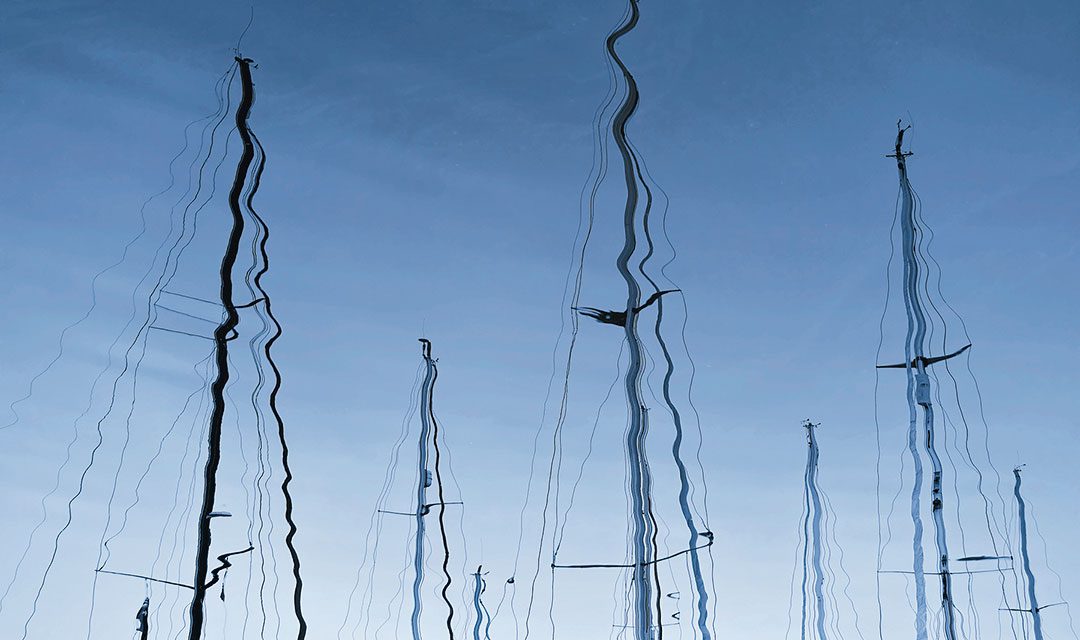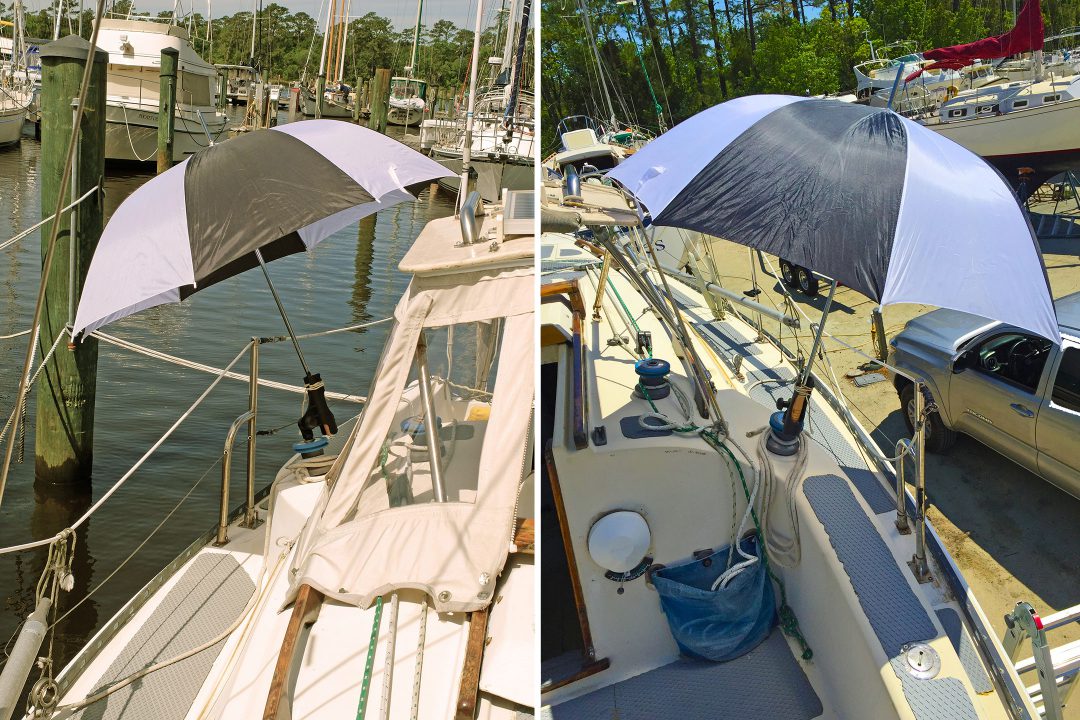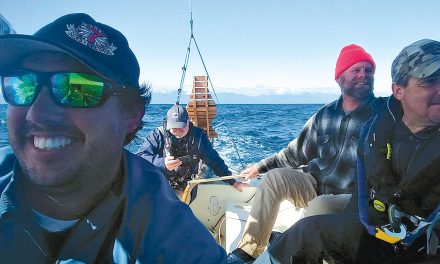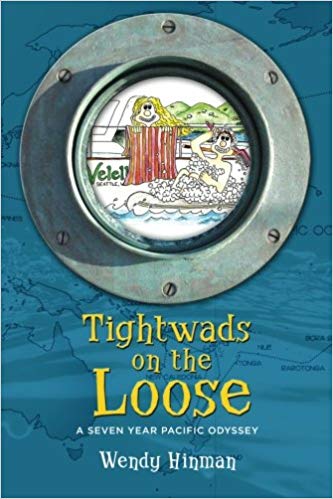Offense Taken
While I appreciate the idea of the umbrella for creating easy cockpit shade (“Cockpit Umbrella,” September 2020), as a 40-years veteran of the Navy, I take offense at your statement that a naval officer is considered one of most useless things aboard a sailboat! I have had to go rescue too many I-know-it-all sailboat sailors to accept your qualifier as a naval officer! Negative BZ!
—Denis Rouleau, O’Day 23, Ashburnham, Massachusetts
In England, they say the worst two things to have on a sailboat are, in order: a British naval officer and a wheelbarrow. An umbrella is actually pretty useful for getting on and off when it’s raining.
—Roger Hughes, Britannia, Florida
I’ve heard a different take on the most useless things on a sailboat: a typewriter, an extension ladder, and a naval officer.
—Ken Thorn, Carrboro, North Carolina
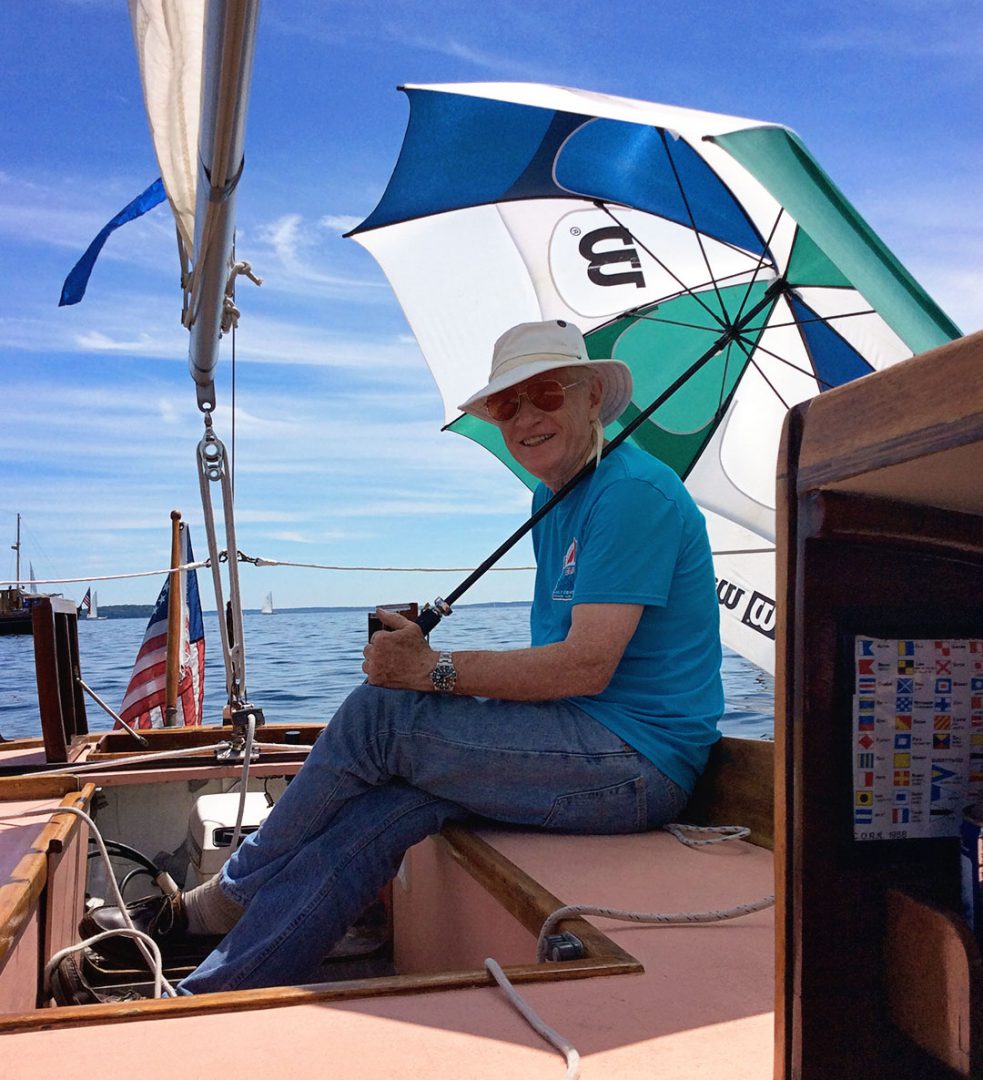 Shady Approach
Shady Approach
Responding to your Dogwatch article on umbrellas (“Cockpit Umbrella,” September 2020), Marionette has one she has used for years (at left). Rain or shine.
—Ron Breault, Old Lyme, Connecticut
More on Mooring Costs
Thanks for your comments on my letter in the recent Dogwatch. However, I don’t think that you appreciate the sheer concentration of population in the northeast and how that drives the cost of dockage for recreational boaters and sailors.
A very large number of Metropolitan New Yorkers (NY Tri-state regional population 20 million) keep their boats in “lower zip code” New England as the driving distances are not prohibitive. (To be clear, not all boaters/sailors are well-heeled, yours truly included. Many of us in the northeastern middle-class are happy to have been grandfathered in when the real estate booms kicked in.) Then there is the Boston/Newport regional crowd and all of a sudden, New England waterfront space is dear. Supply and demand. If “regulations make it impossible to add to the number of slips available to serve a growing West Coast populations,” consider the fact that marinas are closing as developers lust after waterfronts. New York City is a dockage/mooring desert even at the historic seafaring neighborhood of City Island.
The northeast coast from Maine to the Chesapeake have numerous protected waters, bays and inlets for casual daysailing and easy weekend passages. Then there’s the ICW, the protected inland waterway that makes snowbirding possible for many. How many snowbirds do you have on the west coast? Where do you sail when you leave the San Francisco Bay Area (a great natural harbor for sailing)? How about Monterey, San Diego, or L.A.? You mentioned it, geography. The Pacific Ocean coast of California, Oregon and Washington do not give many shelter choices for the weekend cruiser. A Pacific passage to go anywhere is more of a challenge on the west coast. Contrast that with Long Island Sound, Block Island Sound, Narragansett Bay, Buzzards Bay, Cape Cod Bay, not to mention Upper and Lower New York Bay. Delaware Bay is terrible for boaters/sailors but it saves an Atlantic passage to the Chesapeake Bay by leading to the Delaware-Chesapeake Canal which gives an outlet to the bay and the ICW for the Philadelphia/Wilmington (DE) regional crowd. Even that Atlantic passage (Cape May, NJ to the Chesapeake) has Ocean City, MD for relief.
I’m not satisfied either; I wish that dockage and moorings costs were as reasonable here as they are out west. Enjoy it while you can.
—George Bailey, Intended Consequence
George, thank you for the considered response and additional perspective/information. I’m not disputing anything you wrote, but I want to refine a bit of the West Coast portrait you painted.
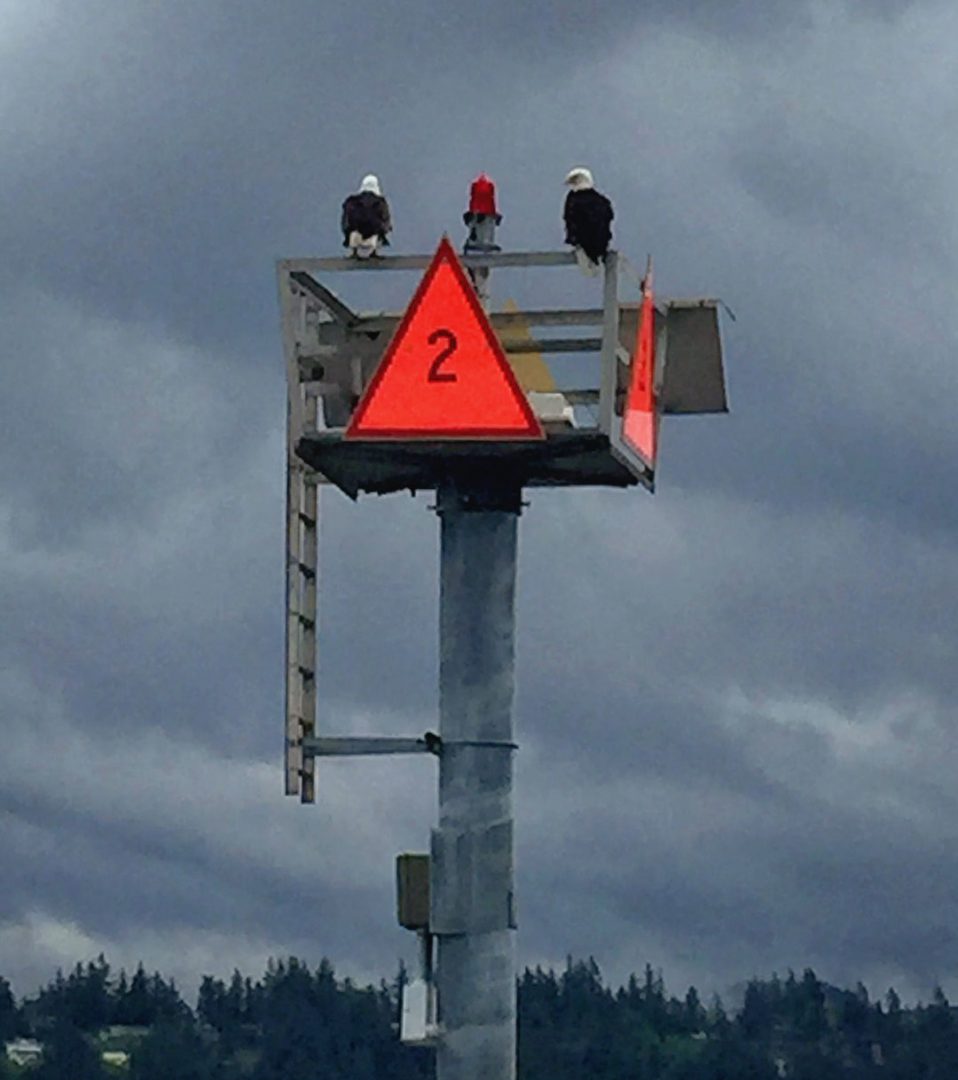
Ron Harben spotted these bald eagles on the way into Bellingham, Washington. “I was crewing on a 1960 60-foot Nordland wooden trawler, from San Diego to Bellingham. The delivery took over a month due to weather and equipment breakdowns.”
Granted that there is an entirely different sailing landscape on the East Coast—Great Lakes too—but there are protected waters in which to sail on the West Coast. Pacific Northwest sailors have all of the Salish Sea and Puget Sound—there’s a lifetime of sailing for those folks. You mentioned San Francisco Bay. Sailors out of Monterrey and Santa Cruz have Monterrey Bay to explore. And where there are few protected waters further south, sailors in Southern California have a ton of destinations within reach. The Channel Islands, a rich network of offshore islands within 14 to 80 miles offshore, can be visited over a long weekend and it feels to the sailor like they’ve been transported to another world.
—Michael Robertson, Editor
It sounds like more sailors need to come down to Texas. In the Houston area, we can keep our Pearson Triton in the water year-round, and our marina has 40’ slips for about $300/month. That fee includes a swimming pool, laundry, and shower facilities. Electricity is separate (and you’ll need to run A/C if you live aboard in the sweltering summers).
It’s not the same scale as Annapolis, but all services are available and there is a good community of sail folk. Blue water starts just outside the Galveston jetties, and then there’s Mexico, Key West, the Caribbean…
Like the rest of the Gulf Coast and Florida, hurricanes are a reality here. In Upper Galveston Bay, we are reasonably protected from all but a direct hit.
—Jesse Einhorn, Isabel, Houston, Texas
Regarding the discussion on mooring costs. Here in Michigan, we face the usual problems of scarce places to keep boats, and more and more of them. The problem is compounded by the fact that many good places to keep boats are also scenic places where people want to live. Many of those people who can afford shoreline dwelling ae not sailors, they just like the view. But it’s often more profitable to build and sell condos and houses than to run a marina, sadly. The problem is far worse in East and West Coast areas, but it’s affecting those of us on the Great Lakes, too.
Going back to the discussion on electric propulsion: One of my two boats lives in a marina 1.5 miles up a river from Saginaw Bay. I rely on the outboard to navigate the dredged channel and marina. Returning to the marina after a recent sail, the wind piped up and blew right on the nose, gusting over 30 knots. I was single-handing and with the mainsail furled on the boom and the jib on deck, there was a lot of windage. The outboard was really cranking just to keep the bow into the wind. Then a big ocean-going freighter appeared, coming down the channel. Our paths would cross right where the dredge and barges were moored just outside the channel. I slowed the outboard enough to maintain steerage (barely), but move so that where our paths crossed I would have space to get out of his way. The experience was harrowing and reminded me of an interview with a world cruiser. The reporter asked the world cruiser if she was ever frightened being out in the middle of the ocean. “Oh no,” she said, “it’s being near the hard spots around the shore that’s intimidating.” A strong, reliable means of propulsion (an outboard in my case) is essential and must be powerful enough to deal with high winds in close quarters.
—Chris Campbell, Traverse City, Michigan
It was the Best of Times, it was the Worst of Times
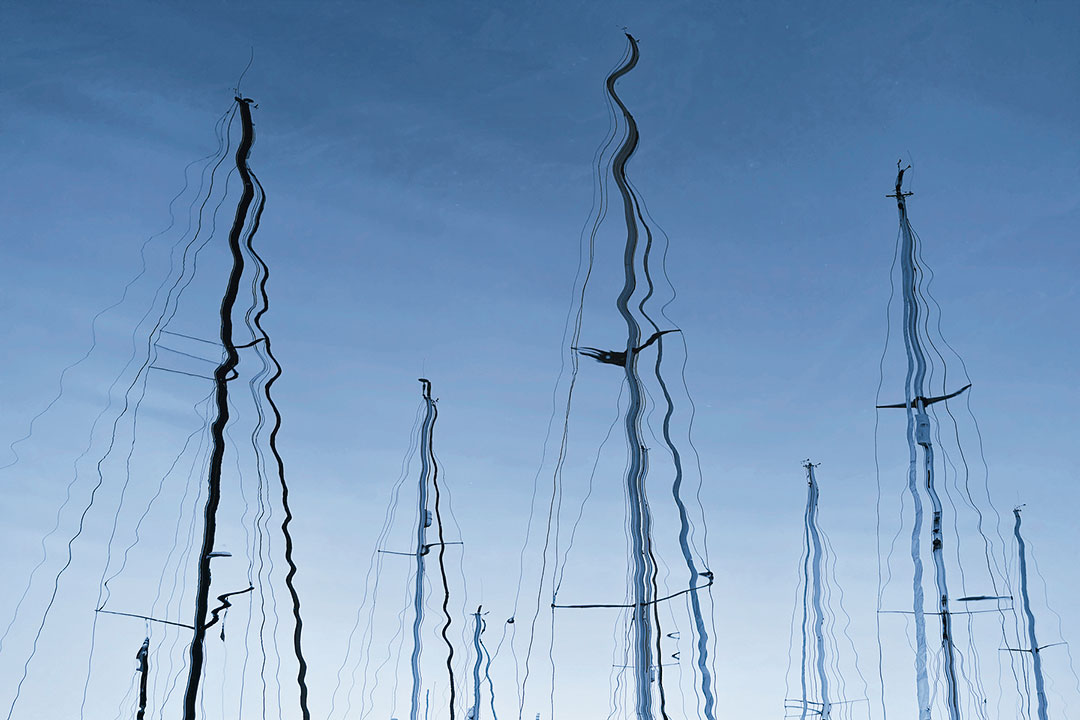
Last month, I put it to readers about the state of sailing in the age of COVID-19. Since March, the pandemic has changed everything, including our sailing lives and the sailing industry. I said that I wanted to create a time capsule of sorts and invited readers to tell their future selves what sailing was like during this time, in no more than 125 words. Following are your responses.
I’m going to give Bill Jacobs the first word…
—Michael Robertson, Editor
***
The incidence of COVID in Florida began in mid-March. It happened to coincide with the anniversary of my 60-year sailing career. Both my age (almost 80) and my ability to tolerate the Florida sun were catching up to me. I donated my Alerion 20 to the yacht club and continued to sail until July. Reluctantly, in this year of COVID, I felt it was time to count my blessings for such a long life of racing, cruising, and daysailing. I have left the club and now spend my time continuing my 10-year writing career (many articles for Good Old Boat, although it has been a while) and also serving on the board of the new Gulf Coast Maritime Museum.
—Bill Jacobs, Palmetto, Florida
I sail Waterparke, a Catalina 34 on the Ottawa River out of the Nepean Sailing Club in Ottawa. With COVID this spring, we faced a questionable launch but finally got in by mid-June. I chose to cancel my Thursday night club racing because my crew would have included people from five different families/bubbles. Instead, my family spent an enjoyable summer cruising, anchoring, and swimming. The Club did organize races that kept everyone separate (measuring elapsed time) and successfully operated its youth training camp and food services with some reasonable rules. Despite the COVID restrictions, sailing provided an active, safe, and enjoyable outlet for a summer unlike any before.
—Parke Davis, Waterparke, Catalina 34, Ottawa
In short, COVID hasn’t much changed the way we sail. I typically sail solo or with my wife, Mimi. Once or twice we’ve invited friends, but knowing how careful they are (masking/social distancing) we don’t worry about being close to them in a breezy, open-air environment.
A local sailor helped introduce some Scouts to sailing and they now have their own boat. I was helping tutor that group, but when COVID cases started to rise again in our county, and as the numbers of youth cases were growing steadily across the U.S., I suggested to the Scoutmaster that we all mask-up when sailing. He declined, so I quit helping.
—Gregg Bruff, Arcturus, Columbia 8.3, Lake Michigan
We were a month late getting launched, but then took our Beneteau 423, Windflyer, from Oakville to the Bay of Quinte and back for two weeks at the end of June. It was unusually quiet, which was lovely! No yacht clubs were yet open and many marinas were still closed, so we anchored a lot. We did miss visiting to Rochester and Sodus Bay (and other places we love). The rest of the summer we spent daysailing.
Fast forward to August and everyone and their brother has purchased a boat and now VHF Ch 16 crackles all day with inexperienced boaters getting into trouble and requiring some kind of rescue.
All in all, it was an awesome summer of sailing for us!
—A. Brian Miller, Oakville, Ontario
My usual cruise along the Florida coast in my Hans Christian 38 was canceled and a passage from Maine to Ireland was put on hold for at least a year. However, as a consolation I was able to sail the coast of Maine for two weeks in the Baba 40 that was slated to take us to Ireland.
In addition, someone gave me a Catalina 22 that I have fixed up to teach my three grandsons to sail, which I am happy to report they love. Hopefully, when I get too old to sail they will let me ride along. All in all, a pretty decent year, but not what we were hoping for.
—David Carstens, Tradewinds, 1977 Hans Christian 38, Mandeville, Louisiana
On Lake Ontario, its been a very positive summer for us, sailing-wise. As a result of COVID, we sailed only with family and thus saw more of them than usual. That was the silver lining for my wife and I (and our kids).
—George Shorey, Wyvern III, 1984 Alberg 34
The Coronavirus, from the POV of the Epiphany crew, had a relatively small impact on the 2020 sailing season. Luckily, Virginia—where we keep our boat—did not lock down boating-related activities, so for the most part, it’s been business as usual. We did carry more provisions than usual and dined out less often. Kudos to our excellent marina for a job well done in keeping a spotless facility; we always felt safe. Deliberately avoiding weekend crowds was perhaps our greatest concession.
—Jennifer Swart, Epiphany, Ericson 35/3
March 13 was the last day the Vermont legislature met. I remember tracking a path through the statehouse that saved me from touching any doors and upon arriving home that night, I learned my job had been transferred to the Health Department.
Squeezing through the locked gate at the Shipyard to varnish and clean was the only (semi) approved activity outside the home or operations center. A small band of masked men assembled to (quietly) put docks in the water at the Lake Champlain Yacht Club in May.
When we finally got in the water, the closure of the Canadian border meant we had Lake Champlain mostly to ourselves. Our small cadre of friends in our cruising bubble would meet at Valcour or Basin Harbor without worry of competition for anchorage and toast or trade books from the dinghy.
We all felt smart, lucky, and a little bit guilty for having a safe place to go. Best summer possible in the worst of times.
—Erik Filkorn, Aylwin, 1985 Ericson 32-3
Life on Lake Champlain is pretty quiet this summer. It seems that most of the larger sailboats on the lake belong to Canadians who are unable to travel to the States, and the boats in most of the northern marinas are up on the hard. The popular anchorages are unusually empty.
But this is not what comes first to mind about this summer. Twice, my wife, Carol, and I have sailed Luna, our 35-foot C&C, down south—once to the Bahamas, and once to southern Florida. We’ve lived aboard her for 8 months during those times. On the way, we’ve stopped to visit friends who invariably say, “You must be really tired of being on the boat, why don’t you stay with us for a few days.” And we’d reply, “No, we actually enjoy being on the boat.” And we do. We like the way she rocks us to sleep at anchor. We like her efficiency of space and our economy of movement as we go about her. We like solving the small problems that arise and appreciate the lack of bigger ones that keep us awake when we’re home. We relish the simplicity of the sailing life.
Because of all the time we’ve spent aboard Luna, we’ve found that off Luna, social distancing (and isolation when necessary) comes easily. To be sailors is to relish contact with others at times, but to be totally at ease and self-sufficient alone and in confined spaces as long as the sea and sky are about us.
—Richard Bernstein, North Ferrisburgh, Vermont
Last winter, I subleased our slip for this year, so we could let our two teenaged girls try dingy racing at another club. Because of COVID, that didn’t happen. I spent the summer lamenting not having the boat in the water. We trailer-sailed it a couple of times, which was pretty painful, but now our boat is finally back in her slip.
We miss the BBQs at the club house, and the sailing school, but we have the boat to spend time together as a family on the lake. Because the girls’ other events have been canceled and they are now homeschooled, we can take off any day the weather is good and I’m home from work. On the whole, COVID has meant we have spent more time together as a family, which has been great. I’m fortunate my work has not been affected—in fact, we are looking at our best year in the last five years.
—Bruce Lyle, 1976 Catalina 27, LYDC, Canada
Sailing during the Pandemic??????? We actually got out almost every weekend for a day cruise. Family only. No guests. What we miss most are guests. We sail a Catalina 25 in Saginaw Bay. Sometimes we remain inside of Wild Fowl Bay when winds are too strong for a comfortable day sail on bigger waters. We were able to return to work in June, about when sailing begins here, so weekend sailing only. Lake levels are at record highs in Great Lakes, so little worry of running aground.
—Stephen Mancuso, Pigeon, Michigan
Right after the lockdown, my sailing partner and I were really unhappy that Maryland had decreed that pleasure boating was verboten, even as our home waters of the Chesapeake Bay from the Bay Bridge to Poole’s Island were open to commercial crabbers. After a month of unrelenting lobbying, the rule was eased and we eagerly bent on the sails. We belong to a club that has regular overnights, but we do not live together and agreed that we would not occupy the saloon at the same time. We have had some of the best summer sailing in memory this year—as well as having escaped the brutal heat waves. Sailing was the lone respite from the crushing events of 2020 and a sanity saver.
—Linda G. Jensen, Mutima, Hammock Island, Maryland
COVID forced my wife and I to race together! She could no longer crew on her friend’s boat, and my crew could no longer crew on our boat, so we teamed up on the water. We lost every race but had fun together, and it gave us something to look forward to outside of the house. A sailing camp was one of the few summer activities still available to the kids. All in all, sailing has been the saving grace of the whole disaster.
—Ben Grooters, Ericson 23 mk2 (w/centerboard)
Because of the pandemic, there were several disappointing, sailing-related cancellations and closures, including the Annapolis-to-Bermuda race, the National Sailboat Show, and our local Sail Nauticus’s teaching and racing programs. It was a comfort, however, to read books such as Lin Pardey’s Self-Sufficient Sailor, to maintain and single-hand my 44-year-old O’Day Mariner in Norfolk Harbor, and to identify from our pier navigational stars and planets during the morning and evening nautical twilights using a star finder and the nautical almanac. During uncertain times, the wisdom of simplicity, the steadiness of the wind, and the predictable positions of celestial bodies proved reassuring.
—John Bowers, Norfolk, Virginia
A strange start to the 2020 sailing season, so quiet in June and early July that sailing singlehanded to Desolation Sound had all the feelings of the Omega Man. I was expecting deserted marinas and supply sources, and yes, it was that quiet. Of course, the worst June weather in years didn’t help the experience much, cold and wet. A few sailing buddies made their way up to Desolation Sound, and we met some very interesting people along the way. As we got into July, the floodgates opened and it seemed that everyone with a boat was out on the water. Interprovincial travel restrictions were eased and out-of-town boat owners arrived. Busier than I’ve seen it in years! A few of our American cousins tried to sneak across the border. RCMP and Boarder Services sent them on their way back with, in some cases, hefty fines. August in the Gulf Islands was busy, lots of boats out and the anchorages crowded. By then all marine services were back in operation, social distances in place. Local boat brokers are reporting brisk sales. I anticipate a glut of boats on the market in about two years, about the time it will take for novices to figure out how much it costs to keep a boat!
—Bert Vermeer, Natasha, Sidney, British Columbia
My older boat (1961 Seafarer Polaris), which usually launches in May, didn’t get in until June 26 as we waited to see what the virus was going to mean. I couldn’t spend my usual March-May weekends doing varnishing, bottom painting, etc. By June, I set aside my maintenance standards and launched. I’ve had more crew aboard this year than usual—being outdoors, in the wind, seems safe enough to enjoy some company. The newer boat (1967 Cal 20) went in even later and came out last week. This summer I met two people who had known her original owner, one of those memorable eccentrics. We exchanged stories about him and they were gratified to know his boat was still in action. Launching my boats was my way of poking the virus in the eye.
—Chris Campbell, Traverse City, Michigan
We live on a boat, so social-distancing was easy, at first, until the season started and the docks got crowded. We were surprised that so many boats were launched.
We started the season with two boats, but we sold one. We thought the boat would never sell, but it went quickly. We are in the process of buying another boat (one up north for the summer, and one down south for the winter).
We went cruising, planning carefully so as to have everything we needed aboard. We went ashore only at uncrowded beaches. No eating out, no shopping, and no sight-seeing. Over Labor Day, we visited a harbor that ended up getting really crowded. It made us nervous having so many people that close.
—Donna Gambino, Blue Moon, 1988 Willard 40 (my husband brought me to the darkside, but we’re working on a deal to buy a Fisher 37 ketch so we will be sailing once again, yay!)

